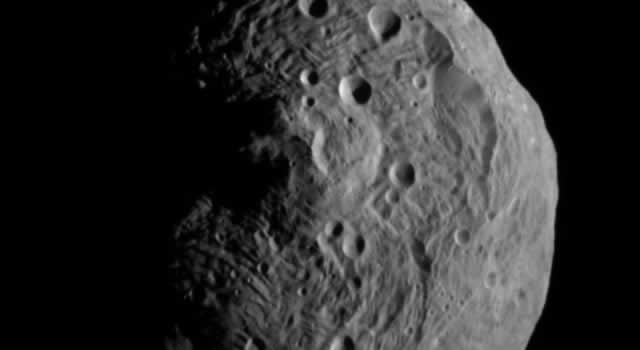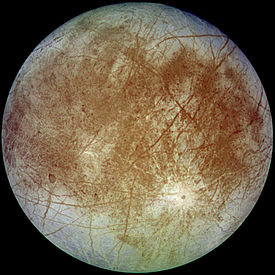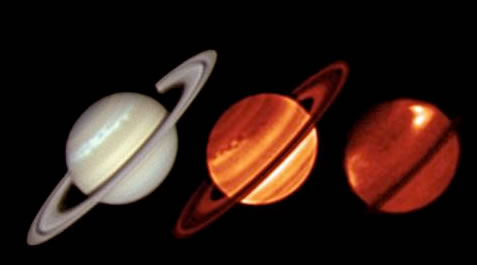 Astronomy
Astronomy
Astronomy is the science of celestial objects such as planets, moons, stars, comets, galaxies, and phenomena originating outside of the Earth. Astronomy should never be confused with astrology. Astrology is the fake belief that the planets and stars control our lives.
Selected articles from Wikipedia on Astronomical subjects
This site will highlight some of the recent discoveries.
 Astronomers have
discovered stars that are as cool as 80 degrees Fahrenheit. The Y
Dwarfs have been theorized for about a decade. The WISE mission has
found them.
Astronomers have
discovered stars that are as cool as 80 degrees Fahrenheit. The Y
Dwarfs have been theorized for about a decade. The WISE mission has
found them.
For details see NASA's WISE Mission Discovers Coolest Class of Stars
NASA’s New Horizons Detects Surface Features, Possible Polar Cap on PlutoVesta
NASA's Dawn spacecraft obtained this image if Vesta with its
framing  camera on July 17, 2011.
It was taken from a distance of about 9,500 miles (15,000 kilometers)
away from the protoplanet Vesta. Each pixel in the image corresponds to
roughly 0.88 miles (1.4 kilometers). Credit:
NASA/JPL-Caltech/UCLA/MPS/DLR/IDA
camera on July 17, 2011.
It was taken from a distance of about 9,500 miles (15,000 kilometers)
away from the protoplanet Vesta. Each pixel in the image corresponds to
roughly 0.88 miles (1.4 kilometers). Credit:
NASA/JPL-Caltech/UCLA/MPS/DLR/IDA
Full frame pictures obtained on 24 July 2011
For more information on asteroids and other Small Solar System Bodies check out this Wikipedia article.
You can also download this free book I created from selected articles on asteroids found in Wikipedia (PDF, 2.3 mb).
A"Big Splat"may be the reason why the far side of the moon is so much more rough than the near side. In short, the far side may be the result of a collision with a smaller moon.

951 Gaspra
 Europa, a moon
of Jupiter
Europa, a moon
of Jupiter
Astronomy Picture of the Day
This excerpt from Wikipedia summarizes how the universe is studied.
Want to know more about the Apollo missions to the Moon? The Apollo Lunar Surface Journal is your place to go!
Speaking of the Moon: the Earth has only one moon... or does it? Earth
with two moon (picture courtesy of Grebenkov; click image for
larger view)
Earth
with two moon (picture courtesy of Grebenkov; click image for
larger view)
Got a question about astronomy? Ask an astronomer.
Observational astronomy
In astronomy, the main source of information about celestial bodies and other objects is the visible light or more generally electromagnetic radiation. Observational astronomy may be divided according to the observed region of the electromagnetic spectrum. Some parts of the spectrum can be observed from the Earth's surface, while other parts are only observable from either high altitudes or space. Specific information on these subfields is given below.
Radio astronomy
Radio astronomy studies radiation with wavelengths greater than approximately one millimeter. Radio astronomy is different from most other forms of observational astronomy in that the observed radio waves can be treated as waves rather than as discrete photons. Hence, it is relatively easier to measure both the amplitude and phase of radio waves, whereas this is not as easily done at shorter wavelengths.
 Although
some radio waves are produced by
astronomical objects in the form of thermal emission,
most of the radio emission that is observed from Earth is seen in the
form of synchrotron radiation,
which is produced when electrons
oscillate around magnetic fields.[35]
Additionally, a number of spectral lines produced by interstellar gas, notably
the hydrogen spectral line at
21 cm, are observable at radio wavelengths.
Although
some radio waves are produced by
astronomical objects in the form of thermal emission,
most of the radio emission that is observed from Earth is seen in the
form of synchrotron radiation,
which is produced when electrons
oscillate around magnetic fields.[35]
Additionally, a number of spectral lines produced by interstellar gas, notably
the hydrogen spectral line at
21 cm, are observable at radio wavelengths.
A wide variety of objects are observable at radio wavelengths, including supernovae, interstellar gas, pulsars, and active galactic nuclei.
Infrared astronomy
 Saturn Northern Storm in Infrared and
Visible Light - May 19, 2011 Image Credit: ESO/Univ. of
Oxford/T. Barry
Saturn Northern Storm in Infrared and
Visible Light - May 19, 2011 Image Credit: ESO/Univ. of
Oxford/T. Barry Thermal infrared images of Saturn from the Very Large Telescope Imager and Spectrometer for the mid-Infrared (VISIR) instrument on the European Southern Observatory's Very Large Telescope, on Cerro Paranal, Chile, appear at center and on the right. An amateur visible-light image from Trevor Barry, of Broken Hill, Australia, appears on the left. The images were obtained on Jan. 19, 2011, during the mature phase of the northern storm. The second image is taken at a wavelength that reveals the structures in Saturn’s lower atmosphere, showing the churning storm clouds and the central cooler vortex. The third image is sensitive to much higher altitudes in Saturn’s normally peaceful stratosphere, where we see the unexpected beacons of infrared emission flanking the central cool region over the storm.
Infrared astronomy deals with the detection and analysis of infrared radiation (wavelengths longer than red light). Except at wavelengths close to visible light, infrared radiation is heavily absorbed by the atmosphere, and the atmosphere produces significant infrared emission. Consequently, infrared observatories have to be located in high, dry places or in space. The infrared spectrum is useful for studying objects that are too cold to radiate visible light, such as planets and circumstellar disks. Longer infrared wavelengths can also penetrate clouds of dust that block visible light, allowing observation of young stars in molecular clouds and the cores of galaxies.[36] Some molecules radiate strongly in the infrared. This can be used to study chemistry in space; more specifically it can detect water in comets.
Optical astronomy
Historically, optical astronomy, also called visible light astronomy, is the oldest form of astronomy. Optical images were originally drawn by hand. In the late 19th century and most of the 20th century, images were made using photographic equipment. Modern images are made using digital detectors, particularly detectors using charge-coupled devices (CCDs). Although visible light itself extends from approximately 4000 Å to 7000 Å (400 nm to 700 nm), the same equipment used at these wavelengths is also used to observe some near-ultraviolet and near-infrared radiation.
Ultraviolet astronomy
Ultraviolet astronomy is generally used to refer to observations at ultraviolet wavelengths between approximately 100 and 3200 Å (10 to 320 nm). Light at these wavelengths is absorbed by the Earth's atmosphere, so observations at these wavelengths must be performed from the upper atmosphere or from space. Ultraviolet astronomy is best suited to the study of thermal radiation and spectral emission lines from hot blue stars (OB stars) that are very bright in this wave band. This includes the blue stars in other galaxies, which have been the targets of several ultraviolet surveys. Other objects commonly observed in ultraviolet light include planetary nebulae, supernova remnants, and active galactic nuclei. However, as ultraviolet light is easily absorbed by interstellar dust, an appropriate adjustment of ultraviolet measurements is necessary.
X-ray astronomy
X-ray astronomy is the study of astronomical objects at X-ray wavelengths. Typically, objects emit X-ray radiation as synchrotron emission (produced by electrons oscillating around magnetic field lines), thermal emission from thin gases above 107 (10 million) kelvins, and thermal emission from thick gases above 107 Kelvin. Since X-rays are absorbed by the Earth's atmosphere, all X-ray observations must be performed from high-altitude balloons, rockets, or spacecraft. Notable X-ray sources include X-ray binaries, pulsars, supernova remnants, elliptical galaxies, clusters of galaxies, and active galactic nuclei.
According to NASA's official website, X-rays were first observed and documented in 1895 by Wilhelm Conrad Röntgen, a German scientist who found them quite by accident when experimenting with vacuum tubes. Through a series of experiments, including the infamous X-ray photograph he took of his wife's hand with a wedding ring on it, Röntgen was able to discover the beginning elements of radiation. The "X", in fact, holds its own significance, as it represents Röntgen's inability to identify exactly what type of radiation it was.
Furthermore, according to the website, in some German speaking countries, X-rays are still sometimes referred to as Röntgen rays, in honor of the man who discovered them.
Gamma-ray astronomy
Gamma ray astronomy is the study of astronomical objects at the shortest wavelengths of the electromagnetic spectrum. Gamma rays may be observed directly by satellites such as the Compton Gamma Ray Observatory or by specialized telescopes called atmospheric Cherenkov telescopes. The Cherenkov telescopes do not actually detect the gamma rays directly but instead detect the flashes of visible light produced when gamma rays are absorbed by the Earth's atmosphere.
Most gamma-ray emitting sources are actually gamma-ray bursts, objects which only produce gamma radiation for a few milliseconds to thousands of seconds before fading away. Only 10% of gamma-ray sources are non-transient sources. These steady gamma-ray emitters include pulsars, neutron stars, and black hole candidates such as active galactic nuclei
